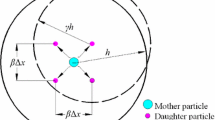Abstract
Two kinds of fractures can be observed in the SPH (smoothed particle hydrodynamics) simulations, which are the physical fracture and the numerical fracture. The physical one exists in reality, while the numerical one is fictitious. This paper presents the effects of both fractures and proposes a simple adding particle technique to avoid the numerical fracture. The real physical fracture is then figured out by using an applicable fracture criterion. Firstly, the effect of the numerical fracture on the computational accuracy is investigated by introducing the artificial fracture in a model of wave propagation. Secondly, a simple adding particle technique is proposed and validated by a three dimensional bending test. Finally, the experiments of penetration on the skin of aircrafts are simulated by both the initial SPH method and the improved method with the adding particle technique. The results show that the improved SPH method can describe the physical fracture very well with better accuracy.
Similar content being viewed by others
References
Randles, P.W. and Liberskyb, L.D., Smoothed particle hydrodynamics: some recent improvements and applications. Computer Methods in Applied Mechanics and Engineering, 1996, 139: 375–408.
Dyka, C.T. and, Ingel, R.P., An approach for the tension instability in smoothed particle hydrodynamics. Computer and Structures, 1995, 57: 573–580.
Belytschko, T., Krongauz, Y., Dolbow, J. and Gerlach, C., On the completeness of meshfree particle methods. International Journal for Numerical methods in Engineering, 1998, 43: 785–819.
Chen, J.K., Beraun, J.E. and Jih, C.J., Completeness of corrective smoothed particle method for linear ealstodynamics. Computational Mechanics, 1999, 24: 273–285.
Xu, F., Zheng, M.J. and Kikuchi, M., Constant consistency kernel function and its formulation. Chinese Journal of Computational Mechanics, 2008, 25: s48–53.
Oger, G., Doring, M. and Alessandrini, B. et al., An improved SPH method: Towards higher order convergence. Journal of Computational Physics, 2007, 225: 1472–1492.
Vidal, Y., Bonet, J. and Huerta, A., Stabilized updated Lagrange corrected SPH for explicit dynamic problems. International Journal for Numerical methods in Engineering, 2007, 69: 2687–2710.
Rabczuk, T., Belytschko, T. and Xiao, S.P., Stable particle methods based on Lagrange kernels. Computer Methods in Applied Mechanics and Engineering, 2004, 193: 1035–1063.
López, H. and Sigalotti, L. Di G., Adaptive kernel estimation and SPH tensile instability. Computers and Mathematics with Applications, 2008, 55: 23–50.
Lastiwka, M., Quinlan, N. and Basa, M., Adaptive particle distribution for smoothed particle hydrodynamics. International Journal for Numerical Methods in Fluids, 2005, 47: 1403–1409.
Shintate, K. and Sekine, H., Numerical simulation of hypervelocity impacts of a projectile on laminated composite plate targets by means of improved SPH method. Composites: Part A, 2004, 35: 683–692.
Xu, F., Chen, J.S. and Huang, Q.Q., The study of numerical stability in the SPH method. Advanced Material Research. 2008, 33–37: 839–844.
Liu, G.R. and Liu, M.B., Smoothed Particle Hydrodynamics — Meshfree Particle Method. World Scientific Publishing Co. Pte. Ltd., 2003.
Katayama, M., Toda, S. and Kibe, S., Numerical simulation of space debris impacts on the Whipple shield. Acta Astronautica, 1997, 40(12): 859–869.
Zhan, Q.W., Guo, W.G. and Li, Y.L. et al., Study on damage of a reinforced aircraft skin subjected to 12.7 mm projectile impact. Explosion and Shock Waves, 2006, 26(3): 229–233 (in Chinese).
Author information
Authors and Affiliations
Corresponding author
Additional information
Project supported by the National Natural Science Foundation of China (No. 10577016), the 111 Project (No. B07050) and the program for 2008 New Century Excellent Talents in University (No. NCET080454).
Rights and permissions
About this article
Cite this article
Xu, F., Zhao, Y., Li, Y. et al. Study of numerical and physical fracture with SPH method. Acta Mech. Solida Sin. 23, 49–56 (2010). https://doi.org/10.1016/S0894-9166(10)60006-7
Received:
Revised:
Published:
Issue Date:
DOI: https://doi.org/10.1016/S0894-9166(10)60006-7



